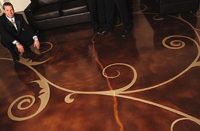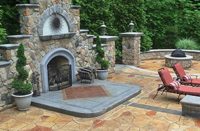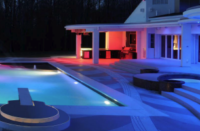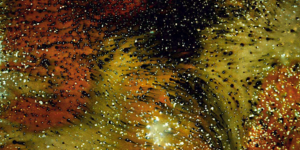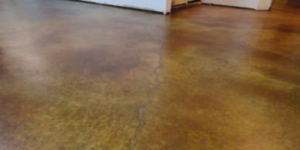
It’s always nice to find a companythat offers the vision of a fine artist, the know-how of a chemist, and the entrepreneurial drive of an inventor. And in the talented team of Bernie Apodaca and Debra O’Leary of Masterpiece Concrete Compositions, you’ll find all these characteristics and more.
 To date, Masterpiece Concrete Compositions has installed over 1 million square feet of both interior and exterior decorative concrete on projects as big as 420,000 square feet and as small as 500 square feet. These include city sidewalks, amusement parks, churches, museums, schools, shopping malls and retail stores, as well as hospitals, hotels, parks, restaurants and private residences. Some well-known completed projects are Showplace, in High Point, N.C., Spirit of Christ Church in Denver and The Wild Animal Park in Escondido, Calif. In San Diego, Masterpiece Concrete has completed projects at The San Diego Zoo, Sea World, PETCO Park, The Hyatt Hotels, and St. Gregory’s Catholic Church.
To date, Masterpiece Concrete Compositions has installed over 1 million square feet of both interior and exterior decorative concrete on projects as big as 420,000 square feet and as small as 500 square feet. These include city sidewalks, amusement parks, churches, museums, schools, shopping malls and retail stores, as well as hospitals, hotels, parks, restaurants and private residences. Some well-known completed projects are Showplace, in High Point, N.C., Spirit of Christ Church in Denver and The Wild Animal Park in Escondido, Calif. In San Diego, Masterpiece Concrete has completed projects at The San Diego Zoo, Sea World, PETCO Park, The Hyatt Hotels, and St. Gregory’s Catholic Church.
Apodaca and O’Leary saw the potential in decorative concrete more than 12 years ago, long before it became wildly popular. The two met while she was working as a project developer for a concrete company; he was an artist with his own graphic design business. A series of events eventually led to a partnership that combined O’Leary’s vision for architectural concrete with Apodaca’s artistic abilities. “I folded up my business that I had for 14 years,” Apodaca says. “I fell in love with concrete and we married our talents together.”
In its infancy, decorative concrete included little more than integral colors or 12-inch-by 12-inch stamped concrete tile patterns. Motivated by a love for concrete and dissatisfied with the industry’s limited options, Apodaca and O’Leary focused their energy on creating new systems and methods using concrete stains, toppings and graphics, all of which could be incorporated on existing concrete as well as other surfaces. The goal was to produce a concrete color finish that looked natural and organic. “If it looks man-made, it’s not good enough,” Apodaca says.
O’Leary also felt limited by the available choices for reactive stain colors. Through experimentation using polymers and a variety of techniques, the two created their own microtopping system that seamlessly blended design with color. For example, back in 1997, one of their San Diego clients wanted to accent their restaurant floor with an additional, yet nonexistent, “eggplant” color in order to complement the reactive stain colors of ochre and patina green, popular color choices at the time. Using their proprietary microtopping system, they were able to incorporate the desired color and design choices and create a concrete floor complete with the desired “eggplant” color as well as a graphic of a guitar with realistic-looking steel strings.
As doors continued to open, the business evolved into Masterpiece Concrete Compositions, a company now in its eighth year. Apodaca and O’Leary have continued to strive for new and innovative ideas to satisfy their clients’ demands for greater artistic creativity in concrete by offering concrete systems and solutions that are not only beautiful but have great durability. “We aren’t married to one type of brand,” Apodaca says. “We come up with a combination of systems to satisfy the needs of the client and the budget.”
 Projects include interior and exterior installations of concrete stain systems, topping systems and graphics on walls, floors, countertops and tub and shower surrounds. Known in the industry for its expertise in problem solving, Masterpiece is accustomed to helping local distributors and manufacturers who refer clients that need solutions for concrete problems. “There is an ‘underlying monster’ in concrete,” Apodaca says. “The right products have to be used on the right surfaces. If not properly diagnosed, projects can fail. Part of the expertise is understanding and knowing the chemistry and science behind it.”
Projects include interior and exterior installations of concrete stain systems, topping systems and graphics on walls, floors, countertops and tub and shower surrounds. Known in the industry for its expertise in problem solving, Masterpiece is accustomed to helping local distributors and manufacturers who refer clients that need solutions for concrete problems. “There is an ‘underlying monster’ in concrete,” Apodaca says. “The right products have to be used on the right surfaces. If not properly diagnosed, projects can fail. Part of the expertise is understanding and knowing the chemistry and science behind it.”
As they look to the future, Apodaca and O’Leary see that in order for architectural concrete to offer true solutions it must become more creative, more durable, physically stretchable and flexible. Transparent concrete anyone?
They also stress that architectural concrete should be valued for its unique look — and that all decorative concrete work should be held to the highest standards. Along with that, contractors should not be afraid to charge what the work is really worth. “They need to charge for the value of creating and installing a handcrafted product,” O’Leary says. “They need to raise the bar.”
“Anyone can buy paint,” Apodaca adds, “but who can paint the Mona Lisa? It’s all about having vision and passion.”
